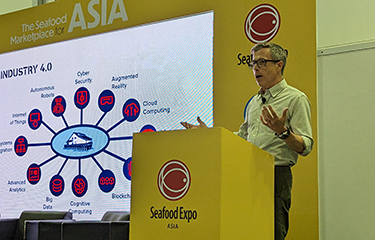The seafood industry is already tapping into the power of AI-based tools, but according to ThisFish CEO and Cofounder Eric Enno Tamm, there’s even more potential for the technology to be used to improve processes.
Speaking during the conference program at Seafood Expo Asia – which ran from 11 to 13 September in Singapore – Tamm said AI has thus far primarily been deployed by the aquaculture sector.
“The rate of innovation in aquaculture is almost double that in fisheries if you look at the number of technology companies that are being launched,” Tamm said.
Based on his analysis of AI companies in the seafood industry, over half are working on projects for aquaculture and many of those are working on machine vision technology – programs that use machine learning and AI to analyze video or images.
“Another way that you could look at this is looking at the amount of investment. Here it even gets a little bit more disproportionate,” Tamm said.
Citing Crunchbase, a database of publicly available information on angel and venture capital investments in industry, Enna Tamm found the seafood industry has spent AI more than USD 610 million (EUR 570 million) on AI-related investments, with roughly USD 590 million (EUR 552 million) of that total going to aquaculture-based projects.
Those investments are “quite disproportionate,” with the majority of investments completed by the world's 10 largest aquaculture companies by size, he said.
“These top 10 companies represent 86 percent of all the – at least publicly disclosed – investment in the industry, so it’s quite lopsided,” Tamm said.
The seafood processing sector has underinvested in AI, according to Tamm. Some companies are using decades-old software to run processing plants, when an AI company, if given the right direction, could help design software that solves problems and increases efficiency.
“The traditional QC inspection of fish is random sampling and it’s manual, and paper-based,” Tamm said.
ThisFish developed software, initially for salmon fillets, that can measure the size of the fillet, classify the color, and find any types of defects on every single fillet that goes through a processing plant.
“Instead of doing random sampling and QC, you’re essentially taking QC of everything,” he said.
The result is that over time yields can be increased, and patterns can be identified the salmon fillets, Tamm said. That data could, in turn, be used to identify what leading factors caused a salmon fillet to be lower or higher quality – tracing back to the farm level.
“If we can take this data from the factory, and link it to the farm outputs, you can use machine learning to figure out what you’re doing on the farm that leads to these quality outcomes,” Tamm said.
Creating a successful AI solution for the industry isn’t as simple as putting together a good algorithm – the data that is fed into the system is key, and what separates the systems that work and those that don’t, he said.
AI can be used for other solutions beyond processing and aquaculture, such as using an AI chatbot to help shrimp farmers solve common problems. An Indonesian farmer with little technical or technological training, for example, could ask a chatbot about a problem and get an answer in their own language. Other solutions, like using an AI to write the standard operating procedures and do technical quality management probe plans, could also save those in the industry time and money while leaving employees to tackle more complicated tasks.
Tamm said improving the uptake and use of AI in the seafood industry will require greater collaboration between the seafood industry and those familiar with AI.
“What we need more than ever ... are people in the industry who have a little understanding of AI, but really understand the industry well, that can come together with technologists like myself with their problems and potentially use AI to solve it,” he said.
Photo by Chris Chase/SeafoodSource







